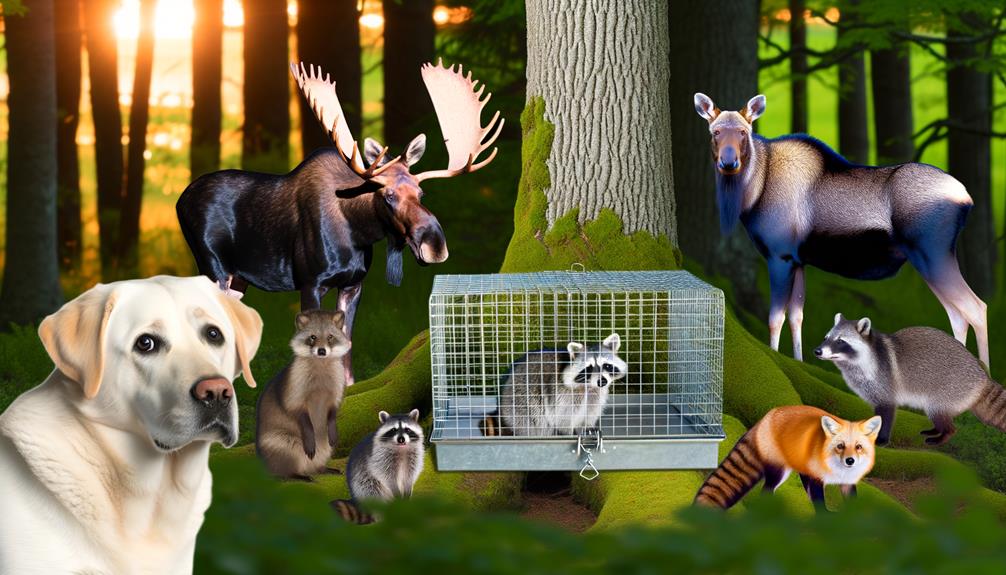Top 10 Dog-Proof Raccoon Traps in Canada
Dog-resistant raccoon traps are essential for efficient and humane wildlife management in Canada, especially for those residing alongside canine companions. Traps should be carefully selected based on design, safety features, and effectiveness.
It's vital to position these strategically and bait them properly to attract raccoons while ensuring the safety of dogs. Adherence to the legalities of raccoon trapping in Canada, including regulations and relocation restrictions, is critical.
Safely handling trapped raccoons requires appropriate protective gear. If you're keen to explore thorough preventive measures and strengthen your property, the following information will be extremely beneficial.

Key Takeaways
- Dog-proof raccoon traps are essential for effective and safe trapping, minimizing harm to pets in Canada.
- Legal regulations in Canada may require specific permits and dictate trap types, placement, and raccoon relocation guidelines.
- Popular dog-proof traps include live cage, body grip, foot hold, and snare, chosen based on safety features and efficacy.
- Strategic trap placement near raccoon dens, food sources, and travel routes enhances success, as does effective baiting and camouflage.
- Safety precautions involve humane treatment of captured raccoons, daily trap checks, and proper handling to avoid disease risks.
Understanding Raccoon Behaviour
In order to effectively use a dog proof raccoon trap in Canada, it is essential to first comprehend the unique behaviours and habits exhibited by raccoons. These nocturnal creatures are known for their intelligence and dexterity, capable of opening containers and doors.
Raccoons are also opportunistic feeders, readily consuming a wide variety of foods, making them common visitors in urban areas where food waste is abundant. Understanding their eating habits can guide in selecting appropriate bait.
Additionally, raccoons are excellent climbers, often found in trees, attics or chimneys. Recognizing these habits is key to strategically placing traps.
Importance of Dog-Proof Traps
Having understood the behaviors and adaptability of raccoons, it becomes clear why the use of dog-resistant traps is of significant importance. These traps offer a safe, ethical, and effective method for managing raccoon populations while minimizing harm to non-target species, specifically dogs.
They are designed to attract raccoons, yet prevent dogs from triggering the mechanism due to their distinct behavioral differences. This is crucial in maintaining the equilibrium of the ecosystem and ensuring the well-being of our canine companions. These traps also contribute to the freedom of property owners, allowing them to guard their homes without fear of harming pets.
Essentially, dog-resistant traps showcase the sophistication of wildlife management, blending efficacy with animal welfare considerations.
Types of Raccoon Traps
In the world of raccoon control, a variety of trapping techniques and trap types exist, each with unique characteristics and effectiveness. Understanding the inherent features of these traps, such as their design, operation, and selectivity, is essential to successful raccoon management.
The subsequent discussion will focus on identifying effective raccoon trapping techniques and providing guidance on choosing suitable raccoon traps.
Effective Raccoon Trapping Techniques
While setting a trap for raccoons, understanding the different types of raccoon traps available can greatly enhance the effectiveness of your capture efforts. The most common types include live cage traps, one-door or two-door, designed for humane catch and release.
Body grip traps, while effective, must be used cautiously due to their lethal nature. Dog-proof traps are particularly beneficial in areas with domestic animals, as they are designed to prevent non-target captures.
Choosing Suitable Raccoon Traps
Now that we've examined the significance of trap selection, let's explore the different types of raccoon traps to better understand which might be the most suitable for your specific needs. The right trap can guarantee the process is humane, effective, and safe for other animals.
Consider the following table summarizing various types of raccoon traps:
| Trap Type | Description |
|---|---|
| Live Cage | These traps capture raccoons alive without causing harm, allowing for safe release. |
| Foot Hold | Utilized mainly by professionals, these require careful handling to prevent injury. |
| Body Grip | Lethal traps designed for quick, humane kills. Not recommended for residential use. |
| Dog Proof | Specifically designed to prevent unintended capture of dogs. Raccoons are lured in by bait. |
| Snare | A loop-style trap, not ideal for beginners due to potential harm to the animal. |
Choose wisely to guarantee a safe, effective trapping experience.
Top Dog-Proof Raccoon Traps
In evaluating the efficacy of dog-proof raccoon traps, three crucial factors are paramount: the choice of the suitable trap, its strategic positioning, and the selection of bait.
The proper trap will be both efficient in capturing raccoons and safe for dogs, ensuring that our canine friends are not accidentally harmed.
Grasping the subtleties of trap placement and baiting can notably enhance the trap's success rate, while reducing any possible risks to non-target animals.
Choosing the Right Trap
Selecting an appropriate dog-proof raccoon trap requires careful consideration of several factors, including its design, safety features, and efficacy.
The design should prevent dogs from triggering the trap, yet remain effective for raccoons. Consider traps with specialised trigger mechanisms designed to be activated by the specific behaviours of raccoons.
Safety is paramount, so make sure the trap doesn't pose a threat to non-target animals or humans. Look for features such as sturdy construction, smooth interior surfaces, and locking mechanisms.
Efficacy is equally important; the trap should successfully capture raccoons without causing them undue stress. Remember, the goal is humane control, not harm.
It may take some research, but finding the right trap is essential for successful and responsible raccoon management.
Trap Placement and Baiting
Once you have selected a suitable dog-proof raccoon trap, the next step involves determining the most effective placement and baiting strategies to ensure successful trapping. Ideal placement locations include around the base of trees, in ditches, or near the raccoon's feeding areas. Consideration should be given to wind direction, the raccoon's travel patterns, and the proximity of domestic animals.
Baiting is vital to attract raccoons, with sweet and strong-smelling foods like marshmallows or fish being particularly effective. It is essential to securely fasten the bait to the trap, so the raccoon must engage with the trap mechanism to access it.
DIY Dog-Proof Raccoon Traps
Crafting a dog-proof raccoon trap requires a blend of ingenuity, practical knowledge, and keen attention to detail, ensuring the safety of your pet while effectively capturing the intrusive wildlife.
Begin with selecting a sturdy, cylindrical object, like a PVC pipe, which allows raccoons to reach in with their nimble paws but prevents larger animals from accessing bait. The length and diameter should be adjusted according to the size of the raccoon's arm and the dog's snout.
Next, secure the cylinder vertically so it stands upright. Bait should be placed at the bottom, enticing raccoons to reach in.
Properly designed, these DIY traps offer an economical, effective, and non-restrictive solution for homeowners dealing with raccoon invasions.
Safety Precautions for Traps
While these homemade traps can effectively capture raccoons without endangering your dogs, it's crucial to keep in mind a few safety precautions to safeguard the wellbeing of all animals involved.
Always make sure that the captured raccoons are treated humanely. Use traps that don't cause unnecessary harm or stress to the animal. Keep in mind that it is illegal to kill, harm, or harass raccoons in most parts of Canada.
Make sure your traps are checked daily to minimize the duration a raccoon stays captured, reducing its stress and potential harm. Additionally, consider wearing protective gloves when handling traps to shield yourself from potential bites or scratches.
Placement Strategies for Traps
The efficacy of a dog proof raccoon trap is not solely determined by its design but also by its strategic placement. Knowing where to position these traps most effectively can greatly increase the chances of capturing a raccoon while minimizing potential risks to dogs.
As a result, we should consider discussing the ideal locations for trap placement and explore effective techniques that can enhance the success rate of trapping.
Ideal Trap Locations
In the vast landscapes of Canada, finding the right location for your dog proof raccoon trap plays a pivotal role in successful raccoon management. The environment and the specific habits of raccoons must be considered to secure the ideal trap location.
- Near Raccoon Dens: Raccoons often reside in trees, under decks, or in sheds. Placing traps near these areas will increase your chances of trapping.
- Food Sources: Raccoons are attracted to areas with accessible food, like trash cans or pet food containers.
- Water Sources: Proximity to water bodies, as raccoons require water for survival.
- Travel Routes: Raccoons follow specific paths when foraging. Setting traps along these routes can be highly effective.
Remember: the freedom to enjoy your property comes with the responsibility of managing wildlife humanely.
Effective Placement Techniques
Having identified suitable locations for your dog proof raccoon traps, it's important to now focus on the implementation of effective placement techniques to guarantee optimal trapping success. In this regard, camouflage is key. Blend the trap with its surroundings by using natural materials like leaves or grass.
Raccoons are naturally curious, but a conspicuous trap might arouse suspicion. Another effective technique is baiting. Utilize foods that are appealing to raccoons but not dogs, like marshmallows or sweet corn.
Moreover, ensure the trap is stable. A wobbling trap can deter raccoons. Anchor your trap to the ground using stakes or heavy objects to eliminate movement.
Lastly, monitor your traps regularly to confirm captured raccoons are promptly and humanely dealt with.
Legalities of Raccoon Trapping in Canada
Regarding the legalities of raccoon trapping in Canada, understanding that regulations vary by province and require adherence to specific guidelines for humane treatment is vital.
For clarity, consider the following key points:
- Each province may have its unique laws and permits required for raccoon trapping. Hence, make sure to familiarize yourself with local regulations before setting up any traps.
- It's illegal in some provinces to relocate trapped raccoons without a permit due to disease control measures.
- Some provinces demand the use of specific trap types that don't harm or cause stress to the raccoon.
- The trapping season may also be regulated. Trapping outside the designated season can result in fines or penalties.
Handling Trapped Raccoons Safely
While adhering to the regulations set for raccoon trapping, it is equally crucial to handle trapped raccoons with utmost care to guarantee both the animal's welfare and your safety.
Consider wearing protective gloves when near the trap to prevent bites or scratches. Raccoons are known carriers of rabies and other diseases, hence direct contact should be avoided.
If the animal appears agitated or distressed, do not attempt to release it immediately. Instead, gently cover the trap with a cloth to create a calming environment.
When transporting the trapped raccoon, make sure the trap is secure to prevent accidents.
Lastly, contact your local wildlife control authorities for guidance on the appropriate release of trapped raccoons, respecting their freedom and natural habitats.
Preventive Measures Against Raccoons
In addition to the careful handling of trapped raccoons, it is also crucial to implement preventive measures to deter these animals from invading your property in the first place. Such measures are not only proactive but also ensure the safety and freedom of both your household and the wildlife.
- Secure Your Trash Bins: Raccoons are attracted to leftover food. Use wildlife-proof bins and secure the lids tightly.
- Limit Outdoor Food Sources: Don't leave pet food outside and pick up fallen fruits from trees promptly.
- Seal Entry Points: Regularly check your property for potential entry points and seal them.
- Install a Fence: A well-installed fence can deter raccoons from entering your yard, especially if it's electrified or embedded into the ground.
Conclusion
To sum up, the use of dog-resistant raccoon traps in Canada offers an effective, humane solution to manage the raccoon population.
It is essential to comprehend the raccoon's behavior, select the suitable trap, and adhere to legal regulations.
Safely managing trapped raccoons and putting preventive measures into place can additionally aid in fostering a harmonious cohabitation with these captivating creatures.
The significance of these actions cannot be emphasized enough, as they can significantly influence our interactions with the wildlife in our vicinity.






